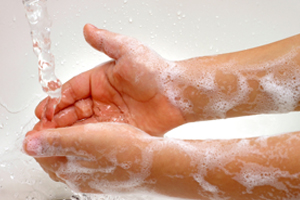








 Before setting off on a cleaning frenzy, it’s important to understand that not all germs are created equal. The germs you may find on your keyboard, while numerous, may not be as dangerous as the few isolated germs found on the toilet seat or in your washer.
Before setting off on a cleaning frenzy, it’s important to understand that not all germs are created equal. The germs you may find on your keyboard, while numerous, may not be as dangerous as the few isolated germs found on the toilet seat or in your washer.
The major zones of filth in the average person’s home are
The kitchen sink is one of the dirtiest places in the house, if not the most, with over half a million bacteria living per square inch in the drain. The combination of food residues, small pools of warm water and wet sponges provides ideal growth opportunities for a host of bacteria.
Recent studies have shown that the toilet, which was thought to be a haven for a multitude of germs, is in fact relatively germ-free. Unfortunately, the few germs that are found there are of the more virulent type, generally E. coli.
As for the bathroom, one would think that the place where one goes to get clean would be clean itself. However, most bathtubs and shower floors are left damp and warm after use, ideal environments for staphylococcus bacteria.
The washer is for most people another unexpected place to find germs. However, most clothes are not washed at temperatures that would kill germs and few washing machine detergents are designed as germicides. Soiled underwear not washed separately can spread E. coli to the entire load.
Electronics that are handled regularly, such as phone, keyboards and mice, have a propensity for letting bacteria survive for relatively long periods of time. Since they regularly come into contact with hands, which are perfect carriers for a multitude of germs, they provide excellent residences for a host of bacteria.
Lastly trash bins, whether indoors or outdoors, provide sheltered conditions and residues for bacteria to grown on. As people tend to avoid cleaning them as often as they should, trash receptacles become perfect locations for germs.
Most breeding grounds for germs can be eliminated with a simple rule: Keep it dry. More effective, cheaper and safer than slathering on anti-bacterial cleaners, dryness can kill virtually all of the germs populating your house. Be disciplined about wiping down your sinks and tubs, eliminating any pools of water, however small. Dry out your sponges fully and wipe down your phones and keyboards on a monthly basis. For those areas were E. Coli is a risk, use small amounts of bleach to kill the bacteria and wash underwear separately.
Most importantly of all, don’t over disinfect as this may cause more serious risks to your health. Living in an aseptic environment is far more damaging that living with a host of generally mild bacteria.
 There has been a debate raging for the past few years about the benefits and dangers of raw versus pasteurized milk and dairy products. Health food proponents contend that raw milk is beneficial to health due to the proteins, delicate enzymes, beneficial bacteria, vitamins and minerals it contains that are destroyed in the process of pasteurization. At the same time, those opposed to raw milk argue that without pasteurization, dangerous bacteria and germs are allowed to proliferate, possibly causing severe illness.
There has been a debate raging for the past few years about the benefits and dangers of raw versus pasteurized milk and dairy products. Health food proponents contend that raw milk is beneficial to health due to the proteins, delicate enzymes, beneficial bacteria, vitamins and minerals it contains that are destroyed in the process of pasteurization. At the same time, those opposed to raw milk argue that without pasteurization, dangerous bacteria and germs are allowed to proliferate, possibly causing severe illness.
There is no simple answer as to which argument is most valid. Heating raw milk to 161 degrees Fahrenheit for 15 seconds to kill bacteria is a process that has been used for more than a century, and was first implemented in the US in the 1890s as a way of helping to reduce the spread of bovine tuberculosis and brucellosis, which were highly contagious diseases thought to be transmitted through drinking raw milk. The most common pathogens it currently destroys are E. coli, Campylobacter jejuni, Listeria monocytogenes and salmonella; bacteria that are particularly dangerous to pregnant women, children, the elderly and those with compromised immune systems.
However, pasteurization kills not only the harmful organisms in milk, but the beneficial ones as well. Some researchers believe that the increasing rates of autoimmune disorders such as type 1 diabetes, allergies, multiple sclerosis and Crohn’s disease over the past 50 years may be due to our lifestlyes being too clean. Those who grow up on farms have been found to suffer less from these diseases, their immune systems having been conditioned through regular exposure to pathogens.
The beneficial substances that are destroyed during pasteurization include lactoferrin, which helps in the absorption of iron and has antimicrobial and antiviral properties, including killing the bacteria responsible for causing cavities; immunoglobulins, which are antibodies that reduce viruses and bacteria and have been found to reduce the symptoms of asthma; and Lactobacilli (the beneficial bacteria in yogurt and probiotic drinks), which digest lactase, making it possible for many of the lactose intolerant to consume dairy products, and which aids in the absorption of calcium, iron and phosphorus.
The US has an average of 70 cases of food poisoning per year from the consumption of raw dairy products, according to the Centers for Disease Control and Prevention. Most modern industrial dairies are hotbeds of pathogens, which is why many dairy cows are routinely treated with antibiotics. However, pastured dairy cows fed on grass carry lower levels of pathogens in their digestive tracts and their milk contains higher levels of beneficial CLA (an essential fatty acid) and less saturated fat, so their milk is healthier.
If you are considering giving raw milk a try, be sure it is from grass-fed cows from a reputable organic dairy. The benefits are many, though it is always good to keep in mind the possible risks involved.
 In previous centuries, the importance of hand washing was not understood, and led to the needless deaths of many millions of people. When performed properly, hand washing is by far the most effective way to reduce the spread of communicable diseases.
In previous centuries, the importance of hand washing was not understood, and led to the needless deaths of many millions of people. When performed properly, hand washing is by far the most effective way to reduce the spread of communicable diseases.
Up to 25% of women in the 19th century died in childbirth from childbed fever (peurperal sepsis), a disease subsequently found to be caused by the bacteria Streptococcus pyogenes, which was inadvertently transmitted to the mothers on the hands of the doctors attending them. When hand washing was instituted in the delivery room, the rate of death dropped to less than 1%.
Washing your hands after using the toilet or changing a diaper is of utmost importance, as the ingestion of even the smallest amount of fecal matter can cause serious illness from deadly pathogens such as E. coli, salmonella, giardiasis and hepatitis A, among others.
Viruses can also be spread via the hands when they come into contact with infectious respiratory secretions, such as after coughing, sneezing, shaking hands with someone or touching an object that has been in the proximity of someone who is ill, then touching the face, particularly the nose, eyes or mouth. This is one of the primary ways of transmitting the virus that causes the common cold.
Those who handle food should routinely wash their hands, not only after using the toilet, but also after touching raw meat, fish or poultry, as the microbes present on uncooked food can cause gastrointestinal infections that can range anywhere from mild to severe.
Other instances in which you should wash your hands are after handling garbage, handling animals or animal waste, visiting or caring for an ill person, or if the hands show visible dirt.
To wash your hands properly you need only two things: soap and clean, running water. If these two are not available, you can use an alcohol-based hand sanitizer that has a minimum 60% alcohol content.
Before washing your hands, remove all rings and other jewelry. Using warm, running water, wet your hands thoroughly, then apply enough soap to work up a nice lather. Keeping your hands out of the water, rub them together, being sure to scrub both the front and backs of your hands, including your wrists, and also washing between the fingers and under the nails. Do this for 20 seconds, then rinse completely under the running water. Turn off the taps with a paper towel and dry your hands thoroughly with a clean towel or air dryer.
 Sales of bottled water have grown at a steady rate, and it’s estimated that people spend between $50 and $100 billion worldwide each year for the stuff. But is it worth it? In a nutshell, bottled water is expensive, bad for the environment and no healthier for you than tap water.
Sales of bottled water have grown at a steady rate, and it’s estimated that people spend between $50 and $100 billion worldwide each year for the stuff. But is it worth it? In a nutshell, bottled water is expensive, bad for the environment and no healthier for you than tap water.
In terms of cost, bottled water can be up to 10,000 times more expensive than tap water. Municipal tap water costs $0.0015 per gallon, whereas bottled water can cost up to $10 a gallon. This works out to 7 cents an ounce. In comparison, gasoline (which most people find expensive) is less than 3 cents an ounce. Additionally, 40% of bottled water is drawn from the same municipal water sources your tap water comes from, but is simply filtered, something you can easily do yourself at home.
Bottled water is bad for the environment in a few ways. First of all, the production of water bottles is very resource intensive, using 17 million barrels of oil, enough to power 1 million cars for a year. Second, only 1 in 5 water bottles are recycled, amounting to 3 billion pounds of wasted plastic that ends up in landfills, and as they are not biodegradable, they will linger for generations, taking thousands of years to decompose, slowly leaching pthalates and other chemicals into the groundwater.
One of the main reasons people buy bottled water is due to the belief that it is healthier than tap water; however, this is a myth. Municipal tap water must adhere to strict monitoring standards as to water quality, something bottled water companies need not do. For instance, bottled water does not need to be checked for E. coli contamination, does not need to provide the water source, is not required to produce regular quality reports and can still be distributed when tap water level standards are not met. Municipal water must be tested for coliform bacteria upwards of 100 times per month, while bottled water is tested once a week. In fact, 22% of bottled water tested proved to have chemical contaminants at levels above state health limits.
The only real benefit of bottled water over tap is if you are traveling in an area where the water is not reliable or there is no access to clean water, or to have some on hand in case of a natural disaster. Apart from that, it is better to make up your own water bottles at home. If the taste of the water in your municipality is not great, an inexpensive carbon filter can easily be used to make it taste just as good as the bottled version.
 When you or someone you love is sick, whether from the flu or bronchitis or any number of illnesses, the most pressing thought is towards recovering as fast and as fully as possible.
When you or someone you love is sick, whether from the flu or bronchitis or any number of illnesses, the most pressing thought is towards recovering as fast and as fully as possible.
In the battle against the bug, antibiotics have often been the sword with which to vanquish the microscopic beasties. Even those people that hold out against using medication and let their own immune systems attempt to triumph often succumb to the perceived “instant cure” that antibiotics seem to offer. What they don’t realize is that many of those who fall sick, take antibiotics, and then promptly recover, would have recovered even had they not taken antibiotics and just waited a few more days. We tend to self-diagnose, often incorrectly, and seek the cure before confirming the cause of the illness. Bronchitis, for example, can be caused by both bacteria and viruses.
Unfortunately, the abuse and misuse of antibiotics, which include over-prescription and failure to complete antibiotic treatment, have led to a rise in superbugs, bacteria that are resistant to all currently available antibiotic treatments. Recently, reports have been issued from European hospitals stating that there has been a frightening rise in superbugs in hospitals, leading to untreatable infections.
The biggest problem with antibiotics has been and still is their over-prescription. They are often prescribed for illnesses that are entirely viral based, such as the flu and colds, making the antibiotics nothing more than placebos against these infections.
Many people don’t understand that antibiotics do not work against viruses. As the name implies, antibiotics work against bacteria, not viruses. Like most living things, bacteria also evolve and as antibiotics kill off the susceptible colonies, resistant colonies expand to fill the space left behind. The more antibiotics are used, the faster the spread of more resistant colonies.
But why do doctors, who surely are aware of the consequences of this scenario, over-prescribe antibiotics? Part of the answer lies in the pressure exerted by the patient on the doctor. A physician is often overloaded with sick patients, especially in the winter when infection rates rise significantly. Patients often demand antibiotics, having experienced rapid recovery under bacterial infections and believing the same will occur with the current infection. Doctors will often prescribe what the patients want rather than what they need, in order to placate the patient and not have to spend too much time on each patient.
The speed of bacterial evolution caused by over-prescription of antibiotics is currently outstripping the speed with which new antibiotics are developed, which will lead to a catastrophic epidemic of untreatable superbugs. More sensible prescription and more appropriate use of antibiotics is essential if we are to keep up and stay healthy.